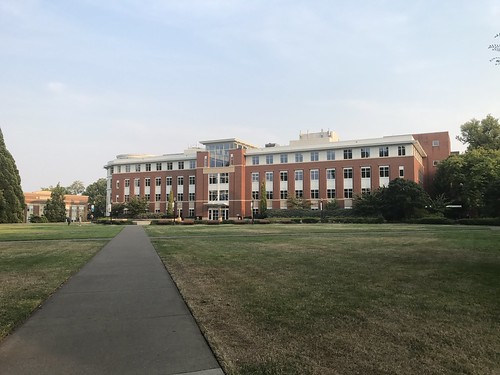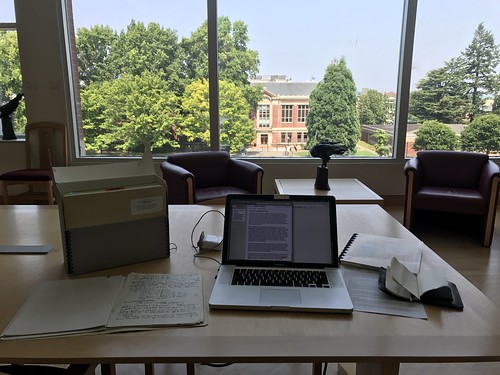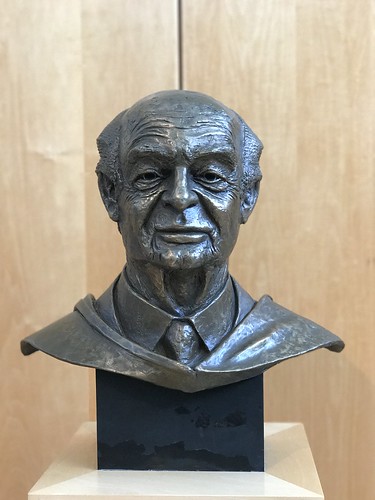I’m in Corvallis for a couple days, doing some work at Oregon State University. My son is here for a rugby camp (how we raised a pair of athletes is beyond me, but I’m glad we did), and I decided to hang here and do some stuff rather than spend an extra 20 hours driving back to California, then returning to collect him.
The Oregon State library is excellent: the main building dates from the 1960s and they had a major remodel and expansion in the 1990s, so it’s all light wood and collaborative workspaces.
The special collections room is especially nice: light, airy, and with a great view of the Library Quad, one of three (!) quads at OSU.
Pauling looms in the special collections. Now, the Pauling papers itself is absolutely vast– thousands of boxes, everything from his research notebooks to DVDs of interviews, covering 70-odd years of his professional life– but the dude is everywhere. Like right outside the front door:
And he should be: Pauling (OSU ’22) is the only person to win two solo Nobel Prizes, and only one of four people ever to win two. Plus, the collection is absolutely beautifully maintained: meticulously cataloged, fanatically well-documented, and super-accessible. It’s a dream.
I came here looking for two things, one of which I figured I’d probably find material on, the other of which was a total crapshoot, and of course 1) is a total bust, and 2) is the success.
Pauling was one of 40 scientists who participated in a long-term study by psychologist Bernice Eiduson of scientists’ psychological profiles and careers. I talk about the study in my book Rest: Why You Get More Done When You Work Less, and how they discovered that one of the big differences between the high-achievers and others was that the first group tended to be more physically active, or have serious hobbies. I’ve long been fascinated by the study, and have some notes about the interviews, thanks to one of Eiduson’s executors; but I want to learn more about the project.
So far, I’ve found exactly one letter between them. One.
So that’s a bust.
The second subject I’ve been interested in is a lot more elusive: it’s how Pauling thought about the role of the subconscious in problem-solving and creativity. Pauling in a 1961 speech on “The Genesis of Ideas” throws out this tantalizing account:
I reached the conclusion some years ago that I had been making use of my unconscious in a well-defined way. I had developed the habit of thinking about certain scientific problems as I lay in bed, waiting to go to sleep. Sometimes I would think about the same problem for several nights in succession, while I was reading or making calculations about the problem during the day. Then I would stop working on the problem, and stop thinking about it in the period before going to sleep. Some weeks or months might go by, and then, suddenly, an idea that represented a solution to the problem or the germ of a solution to the problem would burst into my consciousness.
I think that after this training the subconscious examined many ideas that entered my mind, and rejected those that had no interest in relation to the problem. Finally, after tens or hundreds of thousands of ideas had been examined in this way and rejected, another idea came along that was recognized by the unconscious as having some significant relation to the problem, and this idea and its relation to the problem were brought into the consciousness.
This is a lovely example of Graham Wallas‘ four-stage model of creativity (or the “art of thought” as he called it), in which you work hard (and consciously) on a problem; hit a wall in your effort to solve it, and set it aside for a while; then, have the answer pop up unexpectedly. (John Cleese has a great discussion of the role of sleeping on it in comedy writing.) We all experience small versions of this every day: when we can’t remember the name of a movie, only to have it come to us later while we’re doing something else, the same cognitive mechanism is at work.
Pauling’s use of this method isn’t very well-known, and so I wanted to see if he talked about it elsewhere. I also wanted to try to get a handle on when the “some years ago” had been– 1930, when he was working on applying quantum physics to models of chemical bonding? 1940? 1950?
The challenge is finding things that document this kind of experience, or the evolution of someone’s cognitive style.
The papers of a scientist like Pauling will be organized in several big subsections. The best-organized parts of scientists’ papers usually deal with notable achievements, research projects, committee work, political causes, and other things for which people are well-known, and which later scholars are likely to be interested in. Unless they were involved in some famous project on creativity, or made an extensive study of how they worked, it would be very unusual for papers to have a folder on something like “cognitive style.” So that means you have to figure out where such mentions could be.
In Pauling’s case, there’s also a problem of scale: he wrote and received thousands of letters, and Oregon State also has his research notebooks, drafts of talks and papers, and has his wife’s personal papers. So discussions of how he worked, and specific mentions of “I went to bed thinking about this problem, and now 47 days later I have the answer” could be in any number of places.
If they exist at all. These kinds of moments aren’t necessarily things that people talk about in real time, they may not even recognize them as very important at the time, or they may be reluctant to talk about such episodes until after the insight has been experimentally confirmed. In that case, the best you can do is find the first mention of their use of some technique, or the first retrospective account of how they made a creative breakthrough.
So for me, the challenge is to figure out where things could be. This means figuring out where and when Pauling talked about these things: whether in letters to people, in his research notes, in talks, etc. Then, I have to figure out how that intersects with the archive’s organization of Pauling’s papers. When you’r looking for these ephemeral ideas, you need to think about what kinds of traces they left, and where they might be in the archival or documentary record.
This is what I mean by “strategic wandering.” Unlike the work you do when you’re documenting the relations between two historical figures, or treaty negotiations, or institutional history, recovering the history of cognitive activity– especially unconscious cognitive activity or spontaneous thought— requires finding a piece of the archives where the documentation seems likely to exist, and then just diving in and wandering, observing, and seeing what you can see.
In Pauling’s case, it turns out he made a number of speeches in which he talked about “making use of my unconscious in a well-defined way,” and those seem to be the major source that I have to work with. The first mention is in 1955, in a talk at the AAAS on “The Genesis of Ideas” (an early version of the talk that got me interested in this aspect of Pauling’s work). He then talks about it a few more times, and in a 1969 talk connects it to his insights into the molecular basis of sickle cell anemia, and his theory of the chemical action of anesthesia.
There seems to be no near real-time documentation of these insights, though. Pauling is clear that he had the anesthesia breakthrough in April 1959, but there are no letters from that period mentioning his breakthrough, no research notebook entries that say “unconscious finally delivered result!” Likewise, the sickle cell anemia story stays pretty consistent over the years, but the documentation all seems to be retrospective. I may yet find some place where he talks more in real time about the role of his unconscious in solving problems, and it’s possible that his wife Ava, who was his constant companion, mentions them.
It occurs to me that strategic wandering how all my best work has happened. I don’t create my best work by working through the centers of archives, or reading the same material that everyone else does. My best work has happened when I’ve figured out how to approach a poorly-catalogued collection, or how the “Miscellaneous Letters” section is really organized, and working from there.
This is how I was able to write about collaborations between printers and astronomers at the Lick Observatory. Those collaborations were important to scientists, and they generate a lot of correspondence. But nobody considers letters to tradesmen worth cataloging, so they end up getting thrown into the big bin of “Other letters.” But if you can figure out how to look for them, you can learn some interesting things.
One of the core questions that drove the writing of Rest was, “What do creative people do when they’re not working?” This is something that few historians are interested in. Most biographers rush past their subjects’ vacations or hobbies; they’re interested in their subjects’ work (which is what made them famous), and therefore it would be a waste to look at anything other than their time at work.
And the work of being a futurist is all about taking notice of the curious things that people are doing with new technologies, new ways they’re learning, new ways groups are organizing themselves. Everyone can see the obvious stuff; it’s the non-obvious things that we try to be aware of.
Strategic wandering is also a practice that requires being able to work through a lot of material, because most of it’s going to be irrelevant, and you need to identify what’s important pretty quickly. Here, being able to photograph things in the archives makes a huge difference. When I first started as a graduate student, you could only take notes on paper, with a pencil (Yale even had you use their own paper, which had a hole in the center so they could see if you had slipped a letter in between your own notes!); photographing things was out of the question. Now, so long as you don’t use a flash, you can go crazy. To me, this feels like as a big a change as moving from international calling in the 1970s to Skype: it’s a drop in cost and increase in convenience that’s revolutionary.
But mainly it requires balancing a sense of exactly what you’re looking for, with a willingness to work through a lot of papers, and adjust your parameters– to look for this kind of evidence as well as that, or to shift to a different part of the archive or your subject’s life, and look at what’s happening there. You never really can be certain you’ve hit the right mix of focus and flexibility, but it’s essential to try, and to think regularly about whether you’ve got the balance right.


